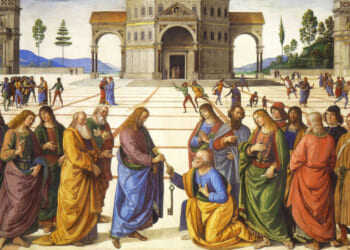Virtuosity comes naturally to Miami City Ballet. Nowhere was this more apparent than in its “Spring Mix” program this season, which presented two brief classics alongside more recent confections before the company ends its thirty-ninth season with the world premiere of what promises to be a stunning reinterpretation of Carmen by Annabelle Lopez Ochoa.
The traditional pieces were bracketed by modern creations. To open the evening, the company programmed a 2014 work by the émigré choreographer Alexei Ratmansky. Once the cat’s meow of post-Soviet ballet in his native Russia, Ratmansky adapted Modest Mussorgsky’s famous Pictures at an Exhibition, here rendered in a piano transcription and played with gravitas by Ciro Fodere, for an ensemble piece for ten dancers. Behind them are visual projections of the earlier émigré artist Vasily Kandinsky’s Color Study: Squares with Concentric Circles. This 1913 futurist composition was intended to transcend representation to reach a new expression of reality through color and form. At the end of the dance, the yellow and blue of the Ukrainian flag is projected in the idiom of Kandinsky’s work. This represents a cause dear to Ratmansky, who grew up and began his dance career in Kyiv (where his parents still live) and who left Russia, likely for good, immediately after the 2022 invasion. Adeline Andre’s costumes are simple but allowed for Ratmansky’s precise, graceful movements to adorn the stage.
The classics included a creation of George Balanchine, his staging of Tchaikovsky’s eight-minute Pas de Deux. Many ballets of all idioms have routines for two dancers, but this one is special. Tchaikovsky composed the music after learning that the ballerina who originated the starring role of Odette in his Swan Lake was dissatisfied with the existing Act III choreography. She had traveled from Moscow to St. Petersburg to ask Marius Petipa, the Imperial Russian Ballet’s longtime ballet master, to create a new routine, which he obligingly did to music by Ludwig Minkus. Tchaikovsky felt upstaged and wrote his own music for the dance, but within parameters that fit Petipa’s choreography. The ballerina was happy with Tchaikovsky’s version. The pas de deux was not included in the definitive version of the score, however, and was presumed lost for more than seventy years, until an archivist accidentally discovered it in the depths of the Bolshoi Theatre’s collections in 1953. Balanchine, by then long ensconced in America, obtained the rights and staged it for New York City Ballet, where it premiered in 1960.
The piece follows a standard pattern, with an entry, a slow movement, a variation for each dancer, and a coda. Situated within the plot of Swan Lake, it demands bravura energy as the ballet races toward its deathly conclusion. The coda defies gravity, requiring a daring midair catch by the male dancer, who must then suspend the ballerina. In Miami City Ballet’s repertoire since 1986, with costumes by Haydée Morales, Pas de Deux here featured Taylor Naturkas and Brooks Landegger, who executed the movements with mesmerizing athleticism.
Situated in the second part of the program, Pas de Deux shared the stage with José Limon’s remarkable solo piece of 1942 Chaconne, which, set to the Chaconne from Johann Sebastian Bach’s Partita No. 2 in D Minor, has no particular plot but is rather an expression of the human spirit. Here the music plays over a neutral set, a black background with lighting designed by Mark Stanley to draw focus to the dancer, a role performed with great vitality by Satoki Habuchi, and to the talented solo violinist Mei Mei Luo.
The evening ended on a hypnotic note with Jerome Robbins’s appositely named Glass Pieces (1983), a combination of more or less classical dance with the repetitive minimalism of the composer Philip Glass, who is still with us at the age of eighty-eight. Set in three movements, the piece arose from Glass’s 1984 opera Akhenaten, about the Egyptian pharaoh who abandoned the ancient gods in favor of monotheism. Robbins was engaged to direct the opera but withdrew and instead brought its dance music to fruition along with two other Glass selections, titled Rubric and Façades. New York City Ballet performed this pastiche just after Balanchine’s death in 1983. Far from the temples of ancient Egypt, the pieces are meant to represent the frenetic pace of urban life, with the dancers simulating the flow of bodies through a cityscape. Robbins did what he could to add variety to Glass’s minimalism, and the dancers conveyed the enhanced meanings well.

















